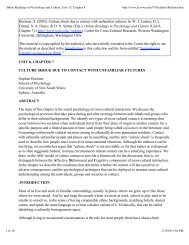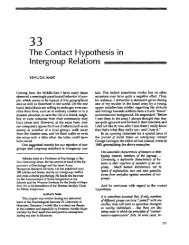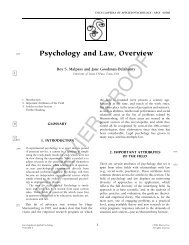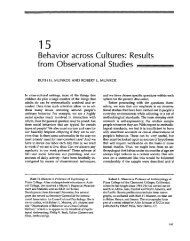From the Lab to the Police Station - Eyewitness Identification Lab ...
From the Lab to the Police Station - Eyewitness Identification Lab ...
From the Lab to the Police Station - Eyewitness Identification Lab ...
Create successful ePaper yourself
Turn your PDF publications into a flip-book with our unique Google optimized e-Paper software.
length hair). Pressing for fur<strong>the</strong>r details commonly yields<br />
guesses or at least information of low accuracy. Fur<strong>the</strong>rmore,<br />
a witness who feels pressure <strong>to</strong> describe a face<br />
may have his or her ability <strong>to</strong> recognize that face later<br />
diminished, a phenomenon dubbed verbal overshadowing<br />
(Schooler & Engstler-Schooler, 1990). Ano<strong>the</strong>r problem<br />
concerns <strong>the</strong> phenomenon of memory source confusions, in<br />
which, for instance, a bystander at a crime is mistakenly<br />
identified as <strong>the</strong> perpetra<strong>to</strong>r (e.g., Read, 1994; Ross, Ceci,<br />
Dunning, & Toglia, 1994). Are <strong>the</strong>re ways <strong>to</strong> minimize <strong>the</strong><br />
chances of such errors? We anticipate as well that <strong>the</strong>re will<br />
be fur<strong>the</strong>r refinements <strong>to</strong> <strong>the</strong> sequential lineup procedure<br />
(e.g., see Levi, 1998b) and that <strong>the</strong>re will be new procedures<br />
that are particularly suitable for child witnesses (see<br />
Pozzulo & Lindsay, 1999). In addition, future research is<br />
likely <strong>to</strong> discover better estima<strong>to</strong>r variables for diagnosing<br />
mistaken identifications after <strong>the</strong>y have happened (postdiction).<br />
Decision times seem <strong>to</strong> be one of <strong>the</strong> most promising<br />
new postdiction variables (see Dunning & Stem, 1994;<br />
Smith, Lindsay, & Pryke, in press; Sporer, 1993). Far from<br />
being <strong>the</strong> finale for psychology's contributions <strong>to</strong> <strong>the</strong> justice<br />
system's understanding, postdiction, and control of<br />
eyewitness error, we see <strong>the</strong> Guide as one example of what<br />
psychology and law enforcement can accomplish <strong>to</strong>ge<strong>the</strong>r.<br />
Early in <strong>the</strong> 20th century, applied psychologist Hugo<br />
Mtinsterberg (1908) claimed that psychology could help<br />
<strong>the</strong> legal system clarify <strong>the</strong> "chaos and confusion" (p. 33)<br />
of eyewitnesses. The brilliant and influential legal scholar<br />
J. H. Wigmore (1909) dismissed Mtinsterberg's claims<br />
with regard <strong>to</strong> what psychology had <strong>to</strong> offer at that time.<br />
Wigmore never<strong>the</strong>less felt that <strong>the</strong> day would come when<br />
psychology could in fact assist <strong>the</strong> legal system in its<br />
struggle with eyewitness evidence. Wigmore fur<strong>the</strong>r stated<br />
that when psychology had something <strong>to</strong> offer <strong>the</strong> legal<br />
system regarding eyewitness evidence, <strong>the</strong> legal world<br />
would be ready <strong>to</strong> receive it. It appears that <strong>the</strong> time has<br />
come, at least in some measure. We think both Mtinsterberg<br />
and Wigmore would be pleased.<br />
REFERENCES<br />
Anderson, R. C., & Pichert, J. W. (1978). Recall of previously unrecallable<br />
information following a shift in perspective. Journal of Verbal<br />
Learning and Verbal Behavior, 17, 1-12.<br />
Aschermann, E., Mantwill, M., & Kohnken, G. (1991). An independent<br />
replication of <strong>the</strong> effectiveness of <strong>the</strong> cognitive interview. Applied<br />
Cognitive Psychology, 5, 489-495.<br />
Berkerian, D. A., & Bowers, J. M. (1983). <strong>Eyewitness</strong> testimony: Were<br />
we misled? Journal of Experimental Psychology: Learning, Memory,<br />
and Cognition, 9, 139-145.<br />
Borchard, E. (1932). Convicting <strong>the</strong> innocent: Errors of criminal justice.<br />
New Haven, CT: Yale University Press.<br />
Bothwell, R. K., Brigham, J. C., & Malpass, R. S. (1989). Cross-racial<br />
identification. Personality and Social Psychology Bulletin, 15, 19-25.<br />
Bower, G. H. (1967). A multicomponent <strong>the</strong>ory of <strong>the</strong> memory trace. In<br />
K. W. Spence & J. T. Spence (Eds.), The psychology of learning and<br />
motivation (Vol. 1, pp. 229-325). New York: Academic Press.<br />
Brandon, R., & Davies, C. (1973). Wrongful imprisonment. London: Allen<br />
& Unwin.<br />
Brigham, J. C., & Brandt, C. C. (1992). Measuring lineup fairness: Mock<br />
witness responses vs. direct evaluations of lineups. Law and Human<br />
Behavior, 16, 475-489.<br />
Buckhout, R. (1974). <strong>Eyewitness</strong> testimony. Scientific American, 231,<br />
23-31.<br />
Bull, R. (1992). Obtaining evidence expertly: The reliability of interviews<br />
with child witnesses. Expert Evidence, 1, 5-12.<br />
Christianson, S. A. (1992). Emotional stress and eyewitness memory: A<br />
critical review. Psychological Bulletin, 112, 284-309.<br />
Connors, E., Lundregan, T., Miller, N., & McEwan, T. (1996). Convicted<br />
by juries, exonerated by science: Case studies in <strong>the</strong> use of DNA<br />
evidence <strong>to</strong> establish innocence after trial. Alexandria, VA: National<br />
Institute of Justice.<br />
Cutler, B. L., & Penrod, S. D. (1995). Mistaken identification: The<br />
eyewitness, psychology, and <strong>the</strong> law. New York: Cambridge University<br />
Press.<br />
Cutler, B. R., Penrod, S., & Dexter, H. R. (1990). Juror sensitivity <strong>to</strong><br />
eyewitness identification evidence. Law and Human Behavior, 14,<br />
185-191.<br />
Cutler, B. L., Penrod, S. D., & Stuve, T. E. (1988). Jury decision making<br />
in eyewitness identification cases. Law and Human Behavior, 12,<br />
41-56.<br />
Davies, G., Shepherd, J., Shepherd, J., Flin, R., & Ellis, H. (1986).<br />
Training skills in police Pho<strong>to</strong>fit opera<strong>to</strong>rs. Policing, 2, 35-46.<br />
Deffenbacher, K. (1983). The influence of arousal on reliability of testimony.<br />
In S. M. A. Lloyd-Bos<strong>to</strong>ck & B. R. Clifford (Eds.), Evaluating<br />
witness evidence: Recent psychological research and new perspectives<br />
(pp. 235-251). Chichester, England: Wiley.<br />
Dekle, D. J., Beale, C. R., Elliot, R., & Huneycutt, D. (1996). Children as<br />
witnesses: A comparison of lineup versus showup identification methods.<br />
Applied Cognitive Psychology, 10, 1-12.<br />
Devenport, J. L., Penrod, S. J., & Cutler, B. L. (1998). <strong>Eyewitness</strong><br />
identification evidence: Evaluating commonsense evaluations. Psychology,<br />
Public Policy, and Law, 3, 338-361.<br />
Devlin, Lord. (1976). Report <strong>to</strong> <strong>the</strong> Secreta~, of State for <strong>the</strong> Home<br />
Department of <strong>the</strong> Departmental Committee on Evidence of <strong>Identification</strong><br />
in Criminal Cases. London: Her Majesty's <strong>Station</strong>ery Office.<br />
Doob, A. N., & Kirshenbaum, H. (1973). Bias in police lineups--partial<br />
remembering. Journal of <strong>Police</strong> Science and Administration, 1, 287-<br />
293.<br />
Dunning, D., & Stern, L. B. (1994). Distinguishing accurate from inaccurate<br />
identifications via inquiries about decision processes. Journal of<br />
Personality and Social Psychology, 67, 818- 835.<br />
Egeth, H E. (1993). What do we not know about eyewitness identification?<br />
American Psychologist, 48, 577-580.<br />
Egeth, H. E., & McCloskey, M. (1984). Expert testimony about eyewitness<br />
behavior: Is it safe and effective? In G. L. Wells & E. F. Loftus<br />
(Eds.), <strong>Eyewitness</strong> testimony: Psychological perspectives (pp. 283-<br />
303). New York: Cambridge University Press.<br />
Finger, K., & Pezdek, K. (1999). The effect of cognitive interview on face<br />
identification accuracy: Release from verbal overshadowing. Journal of<br />
Applied Psychology, 84, 340-348.<br />
Fisher, R. P., & Geiselman, R. E. (1992). Memory-enhancing techniques<br />
.for investigative interviewing: The cognitive interview. Springfield, IL:<br />
Charles C Thomas.<br />
Fisher, R. P., Geiselman, R. E., & Amador, M. (1989). Field test of <strong>the</strong><br />
cognitive interview: Enhancing <strong>the</strong> recollection of actual victims and<br />
witnesses of crime. Journal of Applied Psychology, 74, 722-727.<br />
Fisher, R. P., Geiselman, R. E., & Raymond, D. S. (1987). Critical<br />
analysis of police interview techniques. Journal of <strong>Police</strong> Science and<br />
Administration, 15, 177-185.<br />
Fisher, R. P., Geiselman, R. F., Raymond, D. S., Jurkevich, L. M., &<br />
Warhaftig, M. L. (1987). Enhancing enhanced eyewitness memory:<br />
Refining <strong>the</strong> cognitive interview. Journal of <strong>Police</strong> Science and Administration,<br />
15, 291-297.<br />
Fisher, R. P., & McCauley, M. L. (1995). Information retrieval: Interviewing<br />
witnesses. In N. Brewer & C. Wilson (Eds.), Psychology and<br />
policing (pp. 81-100). Hillsdale, NJ: Erlbaum.<br />
Fisher, R. P., Mello, E., & McCauley, M. L. (1999). Are jurors' perceptions<br />
of eyewitness credibility affected by <strong>the</strong> cognitive interview?<br />
Psychology, Crime, and Law, 5, 167-176.<br />
Fisher, R. P., Quigtey, K. L., Brock, P., Chin. D., & Cutler, B. L. (1990,<br />
March). The effectiveness of <strong>the</strong> cognitive interview in description and<br />
identification tasks. Paper presented at <strong>the</strong> biennial meeting of <strong>the</strong><br />
American Psychology and Law Society, Williamsburg, VA.<br />
596 June 2000 • American Psychologist







